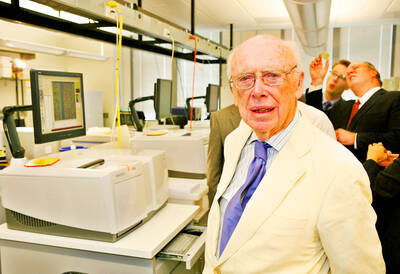Many Indonesians would have survived a deadly earthquake last month if houses had been built out of bamboo and other flexible materials, says an architect on a mission to transform devastated villages.
Eko Prawoto, who is working with homeless survivors in Ngipikan, a village in an area hard-hit by the quake that rocked Central Java and Yogyakarta, blames poor construction techniques for the huge loss of life and injuries.
"Many people who died in this earthquake died because of the brick walls that fell on them," he said.

PHOTO: AFP
The 6.3-magnitude temblor killed 5,800 people, injured up to 40,000 people and destroyed or damaged almost 600,000 houses in the heavily-populated area, which like much of Indonesia faces a constant risk of serious earthquakes.
Many of the houses that were damaged or flattened were built of brick and concrete and featured little reinforcement to resist the shockwaves of the quake, Prawoto says.
A preliminary assessment by the government's Development Planning Agency (Bappenas) also blamed poor construction for the high injury and death toll.
A bookshop and some houses in Yogyakarta built after Prawoto's mostly timber designs survived the May 27 quake undamaged, were his first experiments in quake-resistant construction.
"It's a wooden structure -- which is elastic -- and absorbs shocks ... During an earthquake, you have pushing and pulling forces. Each junction should resist these kind of forces," he said.
In Java, as in much of Indonesia, residences made of bamboo and timber are generally looked down upon as poor people's housing, whereas concrete and brick are viewed as symbols of modernity and rising wealth, Prawoto said.
Nevertheless in the aftermath of the quake, many traumatized villagers now fear living or even sitting inside brick or concrete buildings.
"It's a traumatic experience for them," he said.
For Ngipikan, where almost all the houses were destroyed, Prawoto has designed houses for rebuilding that use traditional materials but have a modern twist: The lower half of the house walls are brick and the upper half bamboo, with coconut trees used for the structural posts.
"It's important to apply bamboo and timber in a different way so as to give the image of newness," he said.
"We use brick but only 1m high -- so in case an earthquake happens again, if it falls down then it's not so dangerous," he said.
Assisted by donations from the local daily Kompas, Prawoto has begun building four of a planned 65 houses. He hopes the houses will serve as a model for other residents looking to build cheap but strong new homes.
With free labor provided by villagers and using recycled timber from the collapsed houses in combination with low-cost bamboo, he estimates each house will cost 10 million rupiah (US$1,060).
The government has promised to pay 30 million rupiah to quake victims whose houses were destroyed, but Prawoto suspects such assistance will take months to be disbursed and people cannot wait that long.

James Watson — the Nobel laureate co-credited with the pivotal discovery of DNA’s double-helix structure, but whose career was later tainted by his repeated racist remarks — has died, his former lab said on Friday. He was 97. The eminent biologist died on Thursday in hospice care on Long Island in New York, announced the Cold Spring Harbor Laboratory, where he was based for much of his career. Watson became among the 20th century’s most storied scientists for his 1953 breakthrough discovery of the double helix with researcher partner Francis Crick. Along with Crick and Maurice Wilkins, he shared the

China’s Shenzhou-20 crewed spacecraft has delayed its return mission to Earth after the vessel was possibly hit by tiny bits of space debris, the country’s human spaceflight agency said yesterday, an unusual situation that could disrupt the operation of the country’s space station Tiangong. An impact analysis and risk assessment are underway, the China Manned Space Agency (CMSA) said in a statement, without providing a new schedule for the return mission, which was originally set to land in northern China yesterday. The delay highlights the danger to space travel posed by increasing amounts of debris, such as discarded launch vehicles or vessel

RUBBER STAMP? The latest legislative session was the most productive in the number of bills passed, but critics attributed it to a lack of dissenting voices On their last day at work, Hong Kong’s lawmakers — the first batch chosen under Beijing’s mantra of “patriots administering Hong Kong” — posed for group pictures, celebrating a job well done after four years of opposition-free politics. However, despite their smiles, about one-third of the Legislative Council will not seek another term in next month’s election, with the self-described non-establishment figure Tik Chi-yuen (狄志遠) being among those bowing out. “It used to be that [the legislature] had the benefit of free expression... Now it is more uniform. There are multiple voices, but they are not diverse enough,” Tik said, comparing it

TOWERING FIGURE: To Republicans she was emblematic of the excesses of the liberal elite, but lawmakers admired her ability to corral her caucus through difficult votes Nancy Pelosi, a towering figure in US politics, a leading foe of US President Donald Trump and the first woman to serve as US House of Representatives speaker, on Thursday announced that she would step down at the next election. Admired as a master strategist with a no-nonsense leadership style that delivered for her party, the 85-year-old Democrat shepherded historic legislation through the US Congress as she navigated a bitter partisan divide. In later years, she was a fierce adversary of Trump, twice leading his impeachment and stunning Washington in 2020 when she ripped up a copy of his speech to the